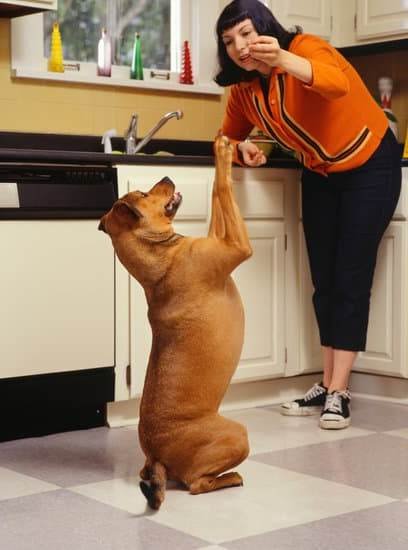Introduction
Encouraging your dog to learn basic commands is one of the most important steps that you can take towards building a loving and trusting relationship between you and your canine companion. Teaching your pup to heed basic commands allows them to learn important communication skills, and it provides both of you with an opportunity to bond and engage in activities together. Furthermore, knowing commands assists dogs by clarity their place in the family and ensures their safety by preventing them from engaging in unwanted behaviors, such as running off or jumping on visitors. Establishing routines around commands can also help dogs feel more secure, as they have a better understanding of what is expected of them.
Analyzing Your Dog’s Learning Ability
Before you can begin teaching your dog to follow basic commands, it is important to understand what they are capable and not capable of learning. Some dogs may have a predisposition to be more passive, while others will show greater enthusiasm for learning. Either way, depending on the breed of your dog, there could be various levels and forms of intelligence that need to be taken into account. One way to assess your dog’s learning ability is to observe their behavior, their reactions when presented with something new or familiar, and their response time when given a task. It is also a good idea to get insight into how easily they can grasp concepts by talking with previous owners and/or trainers, if applicable. By doing some research beforehand and anticipating any potential difficulties with training, you can increase the overall success rate of the program.
Selecting Beneficial Commands to Teach
When training your dog to follow basic commands, deciding on which commands to teach is an important first step. You don’t need to teach your dog every single command, but focusing on the most beneficial ones can make a big difference in their behavior and obedience. The key is to pick the commands that will be used most often in day-to-day life and have the biggest impact on managing your dog’s behavior.
Common commands such as ‘sit’, ‘stay’, ‘down’, and ‘come’ are among the most useful, since they can be used in many situations. Teaching your dog recall or emergency stop behaviors, like stopping before crossing a street or not running off when they see something interesting, is also helpful. Additionally, teaching behaviors like ‘wait’ and ‘leave it’ help manage impulse control and can come in handy when out walking or at home. Other helpful commands like ‘drop’ for retrieving objects, ‘leave’ for food items on the floor, ‘speak’ for barking control and even ‘fetch’ for playing can also be beneficial if needed. Ultimately, picking out which commands work best for you and sticking with those until reliably learned can save time when training your dog.
Crafting Effective Reward Systems
Developing an effective reward system for your dog is a great way to get them to learn basic commands and follow your instructions. It is important to choose rewards that your pup loves such as treats, toys, or even praise. Make sure to give them out quickly after they do something right or obey a command. You also want to avoid giving rewards unpredictably as this can confuse the dog and make it harder for them to learn. Additionally, be sure that the reward itself is not too distracting and does not lead to further bad behaviors, for example giving a treat every time your pooch jumps and barks when you come home from work may result in them continuing to jump whenever you arrive at home. Instead of doing that use positive reinforcement methods like designed verbal praise comments or petting. By being consistent with your rewards, training will become much easier and take less time when teaching basic commands such as “sit” and “stay”.
Tips for Efficiently Training with Rewards
Rewards should be used to encourage desired behaviors and build trust between you and your dog. Here are some helpful tips and tricks on how to efficiently use rewards when training basic commands:
1. Firstly, it is important to correctly identify which type of reward is most suitable for your training program. Food-based rewards tend to work great as they provide an instant reward that dogs enjoy, however at times other rewarding items such as toys, verbal praise or a favorite activity can also be effective.
2. Make sure the rewards your provide are specific to the behavior you want your dog to perform – this may mean offering more than one reward for different commands so that your pup knows exactly what action will be rewarded. This helps them learn faster and stay more focused during training sessions.
3. Use treats wisely! Keep track of how many you’re giving them throughout the session so your pup does not become over-sated and lose interest in their rewards mid-way through the session; eventually working toward only rewarding for each successful attempt at a command instead of continuous reward delivery throughout the session.
4. You should also try using random rewards around their environment to reinforce learned commands – this means showing your pup that they still can get rewarded while they’re out in public or even back home aftertraining sessions by randomly surprising them with a treat or toy when they reliably follow-through with command deliveries outside of set practice times!
Presenting Commands and Appropriate Cues
Training your dog to follow basic commands requires simple repetition. Begin training by introducing your dog to the command, or verbal cue, you would like him to understand. To ensure your dog learns the command, use an appropriate cue each time you present it. For example, when teaching ‘sit’, use the same word and gesture every time you’d like him to do this behavior; i.e., raise your arm and say ‘sit’ firmly but in a pleasant tone of voice. Doing so will help your pet understand what behavior you’re expecting from him in response to that particular cue.
In addition to giving a verbal command (i.e., sit), use an appropriate hand signal for each individual cue as well. Hand signals should be clear and easily recognized by your pet so he knows exactly which behavior is expected of him. For instance, motioning with one arm using a closed fist may indicate a ‘sit’ command, while placing an open palm at chest height could serve as a ‘stay’ command. Teaching your pup these visual cues can give her extra information about what action she should take in response to any given verbal command and help her learn faster overall during training sessions.
Dealing With Challenges During Dog Training
One of the challenges you may encounter when training your dog to follow basic commands is their distractibility. Obviously, it can be difficult for a pup to focus on following commands in environments with a lot of distractions. To combat this, work on basic commands in areas that provide minimal external stimulation first, then build up to more demanding places as your dog progresses. You may want to start a system of treats or rewards when your pup does respond properly – even if it’s a small improvement – so they’re aware when they’ve done something correct and get excited about future positive results from similar actions. Additionally, introduce new environment settings steadily over several days or weeks; don’t haste the process by introducing too much disruption all at once. Lastly, dont forget to be patient with your pup while they learn; they still need time and space to understand the rules you’re teaching them.
Tips for Overcoming Unwanted Behaviors
Unwanted behaviors in dogs can be disheartening, especially when it takes away from the rewards of proper training. However, it is important to remember that undesirable behaviors are normal and often reflect a lack of understanding from the dog or simply need patience from the owner during training. Before teaching your dog to follow basic commands, it is important to address any issues with unwanted behaviors.
This can start by examining why the behavior is happening in the first place. Common causes of undesired behavior include lack of attention, behavioral problems with another pet, anxiety bred out of insecurity or stress, bad habits instilled by former owners or even learned aggression towards humans or other animals. Additionally, many times dogs will act out if their needs aren’t being met. It is important to ensure that you are providing them with plenty of love and exercise as well as making sure they have a safe environment to explore and interact with others in.
After identifying any root causes and attempting to address them, you will want to focus on positive reinforcement techniques as much as possible when teaching your dog basic commands . Use lots of verbal encouragement such as praise and rewards whenever good behavior displays itself and provide clear guidance whenever obedience doesn’t come naturally or immediately. Lastly, make sure the reinforcement period isn’t too long or else a bored pup might not associate good behavior with rewards at all! While overcoming unwanted behaviors does require patience and dedication- following these tips can help set your furry friend up for success!
Conclusion
Training your dog to follow basic commands is a key way to ensure that you and your pet have a healthy and safe relationship. Not only will it help you control situations at home or outside, but it can also be very important in emergency or dangerous situations. Your dog needs these commands for many reasons such as ensuring safety in public places, preventing stressful or difficult scenarios, increasing the understanding between the two of you, and giving your pup clarity and direction. Regardless of why or how you begin training, basic commands are an invaluable tool for improving both communication and respect with your canine companion creating lifelong benefits for both of you.

Welcome to the blog! I am a professional dog trainer and have been working with dogs for many years. In this blog, I will be discussing various topics related to dog training, including tips, tricks, and advice. I hope you find this information helpful and informative. Thanks for reading!





